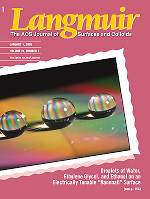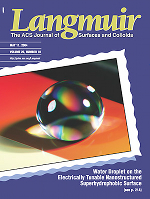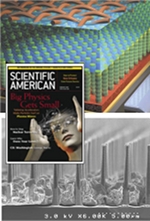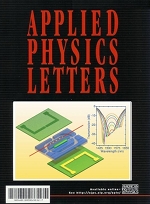Nanonails
|
In this work, we developed a new type of three-dimensional nanoscale surface topography, which we refer to as
“nanonails,” that dramatically alters the wetting behavior of nanostructured substrates. This approach makes it
possible to create superlyophobic substrates – surfaces that resist wetting by virtually any liquid. This is
achieved by “locking” the liquid in a metastable non-wetting state that causes the substrate to “repel” the
liquid even if the analogous flat surface by itself is highly wettable. We demonstrated this approach
experimentally by transforming ordinary fluoropolymer surfaces, which are readily wetted by the majority
of common low-surface-tension liquids, into superlyophobic substrates that completely repel an extremely broad
range of liquids with different chemical natures (alcohols, ethers, esters, water-alcohol mixtures, aromatic
hydrocarbons, silicon oils) and with surface tensions ranging from 21.8 mN/m (ethanol) to 72 mN/m (water).
A. Ahuja, J.A. Taylor, V. Lifton, A. Sidorenko, T. Salamon, E. Lobaton, P. Kolodner, and T. Krupenkin,
“Nanonails – A Simple Geometrical Approach to Electrically Tunable Superlyophobic Surfaces,” Langmuir, 24, 9–14 (2008).
|  |
Nanograss
Nanograss represents a novel type of nanostructured surface with dynamically tunable wetting behavior.
The state of liquid droplets on a nanograss surface can be dynamically and reversibly changed all the way
from a highly mobile rolling-ball state to almost complete wetting by the application of a small voltage
and current. We have examined experimentally and theoretically the evolution of the droplet states and
their dependence on the details of the nanograss geometry. The pro¬posed approach can potentially enable
novel methods of manipulating microscopically small volumes of liquids. This includes low-friction liquid
transport, the ability to precisely control droplet shape and posi¬tion, as well as dynamic control over
the penetration of liquids through the nanostructured layer. The obtained results potentially open
new and exciting opportunities in microfluidics, chemical micro¬reactors, bio/chemical detection
and characterization, optics, drag reduc¬tion, and many other areas.
The work has attracted substantial media attention including Physics Today (2004), The New York Times (2004
) and ABC News (2005). The results of the work are described in 7 publications, one granted and 12 pending patents.
|  |
Nanostructured microbattery-on-a-chip
One of the well-known and long-standing problems in electrical batteries is self-discharge caused
by a slow chemical reaction between the electrolyte and electrodes that occurs in the battery during
its period of inactivity. This problem becomes especially acute in high-power-density batteries, such
as those used by military and emergency systems. Traditionally, these applications employ so-called
reserve batteries, where electrolyte is stored in a separate compartment and brought into contact
with electrodes only upon battery activation shortly before use. Existing reserve batteries are
expensive and do not allow scaling to micro size. We have employed “nanograss” technology to create
a novel, highly-scalable and inexpensive reserve microbattery-on-a-chip. The developed battery can
be considered as a particular example of the nanograss-based chemical microreactor that exploits
controllable initiation of the chemical reaction using penetration of the liquid reagent through
the nanostructured layer. In this case, the liquid reagent is a battery electrolyte, and the solid
reagent is a battery electrode, which is separated from electrolyte by the nanograss layer. Upon
the battery activation, the electrolyte is allowed to penetrate the nanograss and wet the electrode,
thus initiating the electrochemical reaction. We believe that this type of battery can find a wide
range of applications, including self-powered chips, RF tags, and unattended ground sensor networks.
This work has attracted substantial venture capital funding (over $1M per year for three years),
has enjoyed considerable media attention including Scientific American (2006) and ABC News (2006),
and has won an Excellence in Research award (2006).
The results of the work are described in six pending patents, and two papers.
|  |
Electrowetting-actuated tunable liquid microlens
Tunable minimal-energy surfaces such as those formed by liquid-gas and liquid-liquid interfaces exhibit a slew
of interesting and unusual optical properties. They can provide unparalleled opportunities in developing novel
optical devices that combine highly sophisticated optical processing capabilities with the intrinsic simplicity,
high reliability, and low cost of droplet-based microfluidic devices. In this work, we proposed and experimentally
demonstrated a tunable liquid microlens, which consists of a droplet of transparent conductive liquid placed on
a low surface energy dielectric substrate with underlying electrodes. By varying the voltage applied to the
structure, both the position and curvature of the microlens can be changed using electrowetting. As a result,
the precise positioning of the microlens focal spot in all three dimensions is achieved. This translates into
focusing, pan, tilt, and zoom abilities in imaging applications, or light beam steering and focusing in light
control applications. If desired, the position and curvature of the microlens can be permanently fixed at any
stage by employing a polymerizable liquid that can be rapidly solidified in response to an external stimulus,
such as UV irradiation. The dependence of the microlens behavior on the properties of the materials involved
is experimentally investigated and supported by theoretical calculations. Potential limitations of the
microlens performance associated with the contact-angle hysteresis and stick/slip phenomena are outlined,
and possible ways to alleviate them are assessed.
The work has attracted considerable media attention, including New Scientist (2002) and Science News (2003).
The results of the work are described in two publications, 11 granted patents.
|  |
Fiber-based electrowetting-actuated optofluidic devices
Propagation of light through fiber- and waveguide- based optical devices can be substantially
influenced by the optical properties of the surrounding media. Such devices naturally lend themselves
to microfluidic-based control, which provides a number of important advantages over existing approaches,
including very low power consumption, simple thermal management, and a wide range of tunability. In this work,
we developed a new class of tunable microfluidic fiber devices that use specially designed long-period gratings
in which the phase-matching condition is satisfied over a wide spectral range. Dynamic tuning is achieved
by electrowetting-based pumping of microfluidic plugs back and forth over the gratings. As specific examples,
we demonstrate dynamically-tunable broadband attenuators and filters with adjustable profiles by using fluids
with different refractive indices. These devices have a number of attractive features that include in-fiber
design and polarization-independent behavior together with low-power, nonmechanical, fully reversible, and
latchable tuning.
The work won the 2003 Emerging Technologies Award. The results of the work are described in two publications and two patents.
|  |
|